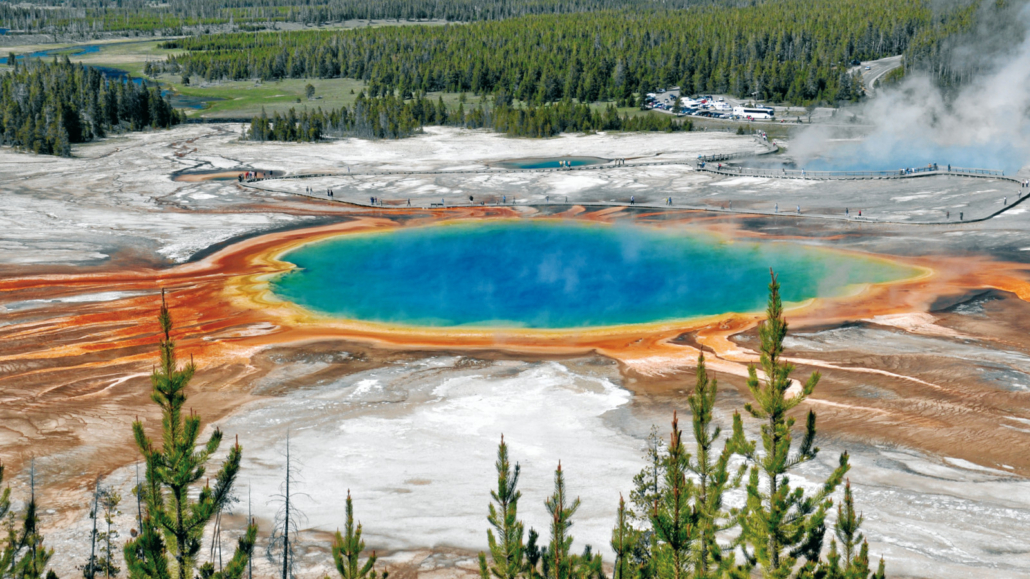
Hot guys in the pool rescue sustainability
The renewable energy sector is ramping up in a major way, but a host of infrastructure issues still need to be solved. One is that supply at times now outstrips demand, but there's no way to store excess power. Turning it into an easy-to-store, energy-rich source like methane could solve the problem. A pivotal aspect of power-to-gas' technology harnesses some tiny helpers usually found in some of the most extreme regions on the planet.
Power-to-gas conversion (P2G) is a technology to watch. But does it really have a bright future? Ultimately, the success of P2G depends on a country’s policy, says Michael Sterner. As the coordinator of Germany’s ORBIT project, he’s conducting efforts by eight partners to develop better bioreactors in the biotechnological synthesis of methane. Funded with €1m by the German Federal Ministry of Economics and Energy, the project is focused on biological methanation, which uses microorganisms to produce green methane from hydrogen. Among the ORBIT partners are three competing companies that are trying to come up with the best technological approach. One of them is Electrochaea.
Power-to-gas was hot in Europe, but not so much then in the US, recalls Mich Hein, head of the Munich-based firm. We actually started in St. Louis as a virtual company. After a few initial steps, we were searching for a location with funding and existing infrastructure to develop our technology. But when Hein couldn’t find that site in the US, he switched gears and headed to Denmark. The owner of the gas grid Energinet.dk recognised the potential for our technology to feed our renewable gas into their grid and meet long term goals for renewable natural gas in Denmark. With a grant of US$1.2m from the Danish Energy Agency (EUDP), we tested our P2G technology using a 10,000-liter reactor vessel, with raw biogas coming from an on-site agricultural biogas reactor. After implementing the technology, the system ran continuously for more than 3,200 hours between August 2013 and February 2014 at Aarhus University’s Biogas Research Center in Foulum. Even though the bioreactor there didn’t have an ideal geometry, the organisms performed better than the rest of the system, Hein says. Every other part of the modified system failed at least once during testing, but the biological catalyst continued to work.
All current P2G concepts are in some way based on two fundamental steps. Excess electricity is used for the electrolysis of water, which produces hydrogen. That’s followed by the reaction of hydrogen and carbon dioxide resulting in methane (methanation), which can be accomplished with or without help from microorganisms. Are bacteria or archaea involved, the process is called biological methanation. The resulting methane – also the main constituent of fossil natural gas – can be fed directly into natural gas networks. We’re finally creating the link between Denmark’s abundance of wind power and production of eco-friendly gas to the Danish gas grid, said Kim Behnke, Head of Environment, Research and Development at Energinet.dk back in 2014. That’s when Electrochaea began to take its technology to the next level with the construction of a demonstration plant in the Danish city of Avedøre.
Archaea also play a central role within the ORBIT project. Constituting the third domain of life (alongside bacteria and eukaryota), these microorganisms have characteristics fitting theories about what very early forms of life on the planet probably looked like. They occur in a wide range of oxygen-free habitats such as marshes and swamps, hydrothermal vents ashore (hot springs, geysers) and at the bottom of the ocean (black and white smokers), but also in the human digestive tract. Within the framework of ORBIT, the interplay between biology, process engineering and unit control is being developed from scratch. Started in mid-2017, the project will run three years. Participating companies hope to gain new insights from the project for the operation and further development of their reactors, which should in turn promote uniform comparison standards in engineering new facilities. So far, most approaches have employed fixed-bed reactors, with gas being introduced from below under high pressure, explains ORBIT coordinator Sterner. However, we’re trying to establish the use of trickle-bed reactors, because they’re much more energy efficient.
No other pigs at the trough
From a process engineering perspective, fixed-bed reactors are possibly less efficient, but so far they’ve been the benchmark in bioreactors that work with archaea. I’ve been surprised how well we’ve been able to maintain basically an archaea monoculture in this open system….although it’s not exactly a monoculture, as we put raw, unfiltered biogas into the reactor, which contains living organisms, explains Hein. But according to the trained chemist and expert plant physiologist, there have so far been no signs of predators’ reducing archaea populations. In a year and four months of operation at full scale in Avedøre, and in seven months of operation in Foulum we have not had an incident of another pig at the trough, Hein says. That is to say, there were no other microbes outcompeting our archaea.
The Avedøre project kicked off in early 2014, construction was completed early last year and soon thereafter, grid quality biomethane was produced. Still running, in thousands of hours of operation, data about the robustness, efficiency, dynamics, productivity, longevity and reliability of the system was collected. In late 2016, Electrochaea – with its headquarters in Munich, Germany, near its key investors – presented plans to build a P2G plant in Hungary. That facility will have a power consumption of up to 10 megawatts of energy – ten times more than the one in Avedøre. When it’s up and running, the Hungarian plant will be the world’s biggest P2G plant, but probably not for long. According to Electrochaea, plants with more than one gigawatt of capacity could become reality around 2025.
The P2G technology is the most advanced commercial technology based on archaea. With regard to scale and utility, I think we’re the most advanced of several competitors, Hein told EuroBiotech. Two of those competitors are collaborators in the ORBIT project: Micropyros and Microbenergy/Viessmann. Micropyros has set up an R&D project in its home town of Straubing (Germany), while Microbenergy is already operating its first – and so far only – P2G demonstration facility in Allendorf (Germany). Both small-scale plants have been running for a couple of years, but there are still no clear plans for a scale-up.
Cultivating thermophiles
In microbiology there are two important temperature ranges: the mesophilic range at about 37°C and the thermophilic range above 55°C, explains Paul Scherer from Hamburg’s University of Applied Sciences. The mesophilic area is preferred by both probiotic and pathogenic bacteria. In order to exclude these potentially harmful bacteria, the fermenters in our working group operate in the thermophilic range – where we’re definitely entering uncharted research territory. Asked about his experiences cultivating thermophilic archaea, Hein particularly mentions two stages: One is where the organisms replicate with high rates. Cell division and cell growth are up. After inoculation, we reach full density in the tank within three days, and the doubling time is between two and a half and three hours. The second stage is different. Only a very little amount of provided carbon accumulates in biomass – if any at all. When we for example checked for detritus of cells after months of methane production, we barely found any. The doubling time is at least 100 hours.
While the organisms themselves are largely newcomers in commercial biotech, the enzymes archaea produce have been around for some time in the sector. Many play important roles in industrial biotechnology. Nearly all extremophiles are from the archaea domain. In a review, Jennifer Littlechild from the University of Exeter (UK) summarised that some of these biocatalysts are already being used in large-scale industrial processes for the production of optically pure drug intermediates, amino acids and their analogues. One such industrial process, used to produce specific L-amino acids, makes use of an L-aminoacylase enzyme. A thermophilic archaeal version of the enzyme has been cloned and over-expressed from Thermococcus litoralis. Another prominent example is an alcohol dehydrogenase enzyme from the hyperthermophilic Aeropyrum pernix. It’s used industrially to make chiral alcohols.
An ancient past, a bright future
Many other archaeal enzymes have been characterised at laboratory scale according to their substrate specificity and properties for potential industrial applications. The increasing availability of DNA sequences from new archaea species and metagenomes provided by next-generation sequencing technologies is a constantly expanding resource in the race to identify new enzymes of commercial interest. Danish enzyme expert Novozymes knows a lot about the special features of enzymes that have been isolated from archaea. A spokesperson told EuroBiotech: The main advantage of extremozymes like thermophilic enzymes lies in the high industrial process temperatures during enzymatic conversion. This is the case in processes that need to modify starch and lignocellulose for food or bioenergy. Littlechild adds that the increased use of enzymes from extremophilic archaea offers the opportunity to access biocatalysts that are naturally stable in a variety of different conditions (temperature, pH, salinity or pressure). She says that makes them suited to different industrial processes than mesophilic microbes.
Let’s wrap things up by returning to the energy sector, where some new technologies are focussing on storaging a liquid rather than a gas: methanol. The short alcohol is extremely versatile, and can be stored more easily than methane. It can be burned to provide heat, generate electricity or power a vehicle. Power-to-liquid (P2L) approaches harness atmospheric carbon dioxide, water, electricity and some special enzymes. European Space Agency spin-out Skytree is now working together with German company Gensoric to develop the world’s first residential P2L system. Its willpower’ system, the company claims, will allow anyone to produce their own fuel at home from surrounding resources. The European Commission is backing the project with a €1.7m grant. Instead of heating a large reactor, the system only brings the immobilised enzymes to the desired temperature. That saves energy. A first pilot plant was installed in Essen (Germany) this year. The firm hopes a crowdfunding campaign that runs into October will provide more money to develop a product for the mass market. Enzyme-driven, CO2-neutral fuel production in the garage – isn’t it a charming vision?
(First published in European Biotechnology, Autumn Edition 2017)


 Die Hoffotografen GmbH
Die Hoffotografen GmbH GSK
GSK